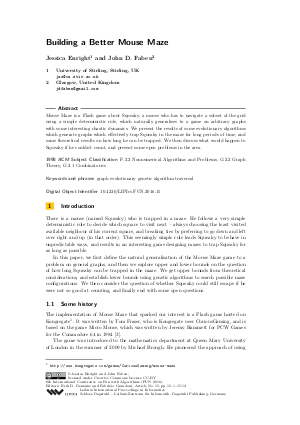Building a Better Mouse Maze
Authors Jessica Enright, John D. Faben
-
Part of:
Volume:
8th International Conference on Fun with Algorithms (FUN 2016)
Part of: Series: Leibniz International Proceedings in Informatics (LIPIcs)
Part of: Conference: International Conference on Fun with Algorithms (FUN) - License:
 Creative Commons Attribution 3.0 Unported license
Creative Commons Attribution 3.0 Unported license
- Publication Date: 2016-06-02
File

PDF
LIPIcs.FUN.2016.15.pdf
- Filesize: 0.51 MB
- 12 pages
Document Identifiers
Subject Classification
Keywords
- graph
- evolutionary
- genetic algorithm
- traversal
Metrics
- Access Statistics
-
Total Accesses (updated on a weekly basis)
0PDF Downloads0Metadata Views
Abstract
Mouse Maze is a Flash game about Squeaky, a mouse who has to navigate a subset of the grid using a simple deterministic rule, which naturally generalises to a game on arbitrary graphs with some interesting chaotic dynamics. We present the results of some evolutionary algorithms which generate graphs which effectively trap Squeaky in the maze for long periods of time, and some theoretical results on how long he can be trapped. We then discuss what would happen to Squeaky if he couldn't count, and present some open problems in the area.
Cite As Get BibTex
Jessica Enright and John D. Faben. Building a Better Mouse Maze. In 8th International Conference on Fun with Algorithms (FUN 2016). Leibniz International Proceedings in Informatics (LIPIcs), Volume 49, pp. 15:1-15:12, Schloss Dagstuhl – Leibniz-Zentrum für Informatik (2016)
https://doi.org/10.4230/LIPIcs.FUN.2016.15
BibTex
@InProceedings{enright_et_al:LIPIcs.FUN.2016.15,
author = {Enright, Jessica and Faben, John D.},
title = {{Building a Better Mouse Maze}},
booktitle = {8th International Conference on Fun with Algorithms (FUN 2016)},
pages = {15:1--15:12},
series = {Leibniz International Proceedings in Informatics (LIPIcs)},
ISBN = {978-3-95977-005-7},
ISSN = {1868-8969},
year = {2016},
volume = {49},
editor = {Demaine, Erik D. and Grandoni, Fabrizio},
publisher = {Schloss Dagstuhl -- Leibniz-Zentrum f{\"u}r Informatik},
address = {Dagstuhl, Germany},
URL = {https://drops.dagstuhl.de/entities/document/10.4230/LIPIcs.FUN.2016.15},
URN = {urn:nbn:de:0030-drops-58743},
doi = {10.4230/LIPIcs.FUN.2016.15},
annote = {Keywords: graph, evolutionary, genetic algorithm, traversal}
}
Author Details
References
- Bilgehan Çavdaroğlu and Fuat Balcı. Mice can count and optimize count-based decisions. Psychonomic Bulletin &Review, pages 1-6, 2015. URL: http://dx.doi.org/10.3758/s13423-015-0957-6.
-
Andrew Drizen. private communication, 2016.

-
Jane Green, editor. Personal Computer World: Best of PCW Software for the Commodore 64. Century Communications, 1984.

-
Zbigniew Michalewicz and David B. Fogel. How to Solve It: Modern Heuristics. Springer, 2000.

